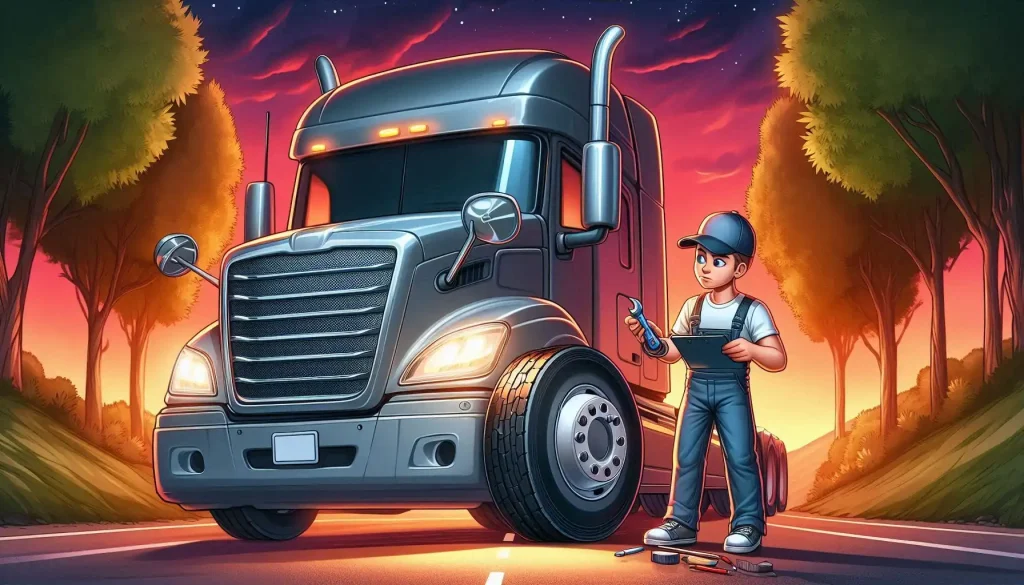What is an Over The Road (OTR) Truck Driver?
Picture this: a trucker cruising down a sunlit highway, hauling freight across state lines, living a life of freedom and grit. That’s the world of an over-the-road (OTR) truck driver. But what is an OTR truck driver, really? This guide dives deep into the role, responsibilities, rewards, and realities of OTR trucking in 2025. Whether you’re eyeing a career behind the wheel or simply intrigued by the open road, here’s your roadmap to understanding this vital profession.
Defining OTR Trucking: What’s in a Name?
An OTR truck driver is a long-haul warrior, transporting goods over vast distances—think cross-country treks or multi-state journeys. Unlike local drivers who clock out nightly or regional haulers who stay within a tighter radius, OTR drivers embrace the highway for days or weeks at a time. Their rigs, often equipped with sleeper cabs, become mobile homes as they deliver everything from furniture to fresh produce.
In 2025, OTR trucking powers America’s supply chain, moving over 70% of the nation’s cargo (ATA data). It’s a job that blends endurance, independence, and a knack for logistics.
What Does an OTR Truck Driver Do?
The gig isn’t just about steering a big rig. Here’s what an OTR truck driver handles on the regular:
- Marathon Drives: Piloting 18-wheelers across hundreds or thousands of miles, often overnight.
- Freight Oversight: Loading, securing, and unloading cargo while ensuring it arrives intact.
- Truck TLC: Running safety checks on brakes, lights, and fuel levels before and after trips.
- Route Mastery: Mapping out paths, dodging roadblocks, and hitting delivery deadlines with GPS precision.
- Rule-Keeping: Sticking to federal regs, like the FMCSA’s Hours of Service, to stay safe and legal.
These drivers are the unsung heroes of commerce, keeping shelves stocked and industries humming.

Life on the Long Haul: A Peek Inside
Curious about the OTR rhythm? Imagine waking at dawn in a sleeper cab, brewing coffee on a portable stove, then rolling out for a 600-mile haul. A driver might log 10 hours behind the wheel—pushing the legal limit—pausing at truck stops for a burger or a quick nap. Deliveries done, they snag another load and keep moving.
The road throws curveballs: a sudden storm in Texas, a jam on I-95, or a late shipper in Oregon. Most OTR drivers stay out 3-5 weeks, grabbing a short home break before the next run. It’s a grind, but for many, the freedom outweighs the fatigue.
How Much Do OTR Truck Drivers Make in 2025?
Money matters, right? In 2025, OTR truck drivers pull in a solid paycheck. Per industry reports (e.g., ZipRecruiter), median earnings range from $75,000 to $95,000 yearly. Rookies might start at $55,000, while seasoned pros hauling specialized loads—like refrigerated goods—can top $110,000.
Perks often sweeten the deal:
- Medical and retirement plans.
- Mileage bonuses (e.g., $0.60-$0.80 per mile).
- Home-time allowances after long stints.
Pay depends on the gig—some drivers bank per mile, others snag a steady salary. Browse trucking jobs to scope out rates.
Earnings of an OTR Driver

One of the most frequently asked questions about being an OTR driver is, “How much can I earn?” The answer varies depending on factors such as experience, the company you work for, and the type of cargo you transport.
According to data from PayScale, the average salary for an OTR truck drivers in the USA was around $62,122 in 2024. The salaries typically ranged from $41,000 to $87,000 per year. However, some sources suggest that the average salary could be as high as $111,772 per year.
Entry-level trucking jobs in OTR with less than a year of experience can expect to make an average total compensation of $53,277. On the other hand, an early career in otr trucking with 1-4 years of experience earns an average total compensation of $60,917.
It’s important to note that these figures are averages and actual earnings can vary. Some companies offer benefits like 401(k), health insurance, and bonuses, which can significantly add to the total compensation.
In conclusion, while the life of a trucking otr comes with its challenges, it can also be financially rewarding. With experience and time, drivers have the potential to make a comfortable income.
OTR vs Regional
An OTR truck driver, as the name suggests, is a truck driver who travels over long distances, often across states and sometimes even across countries. Unlike regional truck drivers who operate within a specific region, OTR drivers are on the road for extended periods, sometimes for weeks at a stretch.
A Day in the Life of an OTR regional Driver
The life of an OTR regional truck driver is one of adventure and challenges. Each day brings new landscapes, new routes, and new experiences. Their day begins with a thorough check of their vehicle, ensuring it’s in top condition for the long journey ahead. The cargo they carry varies widely, from food products to heavy machinery, each with its own set of handling requirements.
Your Path to Becoming an OTR Truck Driver
Dreaming of the driver’s seat? Here’s how to make it happen in 2025:
- Check the Basics: Be 21+, have a clean record, and pass a drug screen.
- Get Your CDL: Enroll in a 4-10 week Class A training course. See CDL tips.
- Cut Your Teeth: Join a company offering rookie training—many pay while you learn.
- Land an OTR Gig: Apply with carriers like Swift or Werner via job boards.
- Keep It Legal: Renew your CDL, stay drug-free, and follow DOT rules.
Training runs $4,000-$8,000, but some employers cover it. Start with local CDL schools.
Requirements and Qualifications
To become an OTR truck driver, one needs a Commercial Driver’s License (CDL), just like regional truck drivers. However, the life of an OTR driver demands additional skills and qualities. They need to be comfortable with long periods away from home, have excellent navigation skills, and be able to handle the rigors of the road.
OTR vs. Other Trucking Gigs: A Side-by-Side Look
Not sold on OTR? Compare it to other paths:
| Role | Range | 2025 Earnings | Time at Home |
|---|---|---|---|
| OTR | 600+ miles | $75K-$95K | Every 3-5 weeks |
| Regional | 150-600 miles | $60K-$80K | Every weekend |
| Local | Under 150 miles | $48K-$65K | Nightly |
OTR pays big but demands time away. Regional or local might suit homebodies better.
The Rewards and Challenges
OTR trucking is not just a job; it’s a lifestyle. It offers the chance to see the country, meet people from diverse backgrounds, and experience the freedom of the open road. However, it also comes with its share of challenges. Long hours, tight schedules, and extended periods away from home, unlike local drivers, are part and parcel of the work.
The Impact of OTR Drivers on the Economy
OTR trucking are a vital cog in the economic machine. They ensure the smooth transportation of goods across long distances, keeping trucking company running and consumers supplied. Their role is particularly crucial in times of emergencies when they deliver essential supplies across state lines.
Being an Over The Road truck driver is a unique profession that offers a blend of adventure, independence, and responsibility. It’s a career that demands dedication and resilience but offers rewards in equal measure.
In the trucking industry, understanding the differences between OTR (over-the-road) truck drivers, regional truck driving, and local truck driving is essential. These terms define the scope of drivers’ routes and significantly affect their lifestyle, earnings, and requirements. Let’s explore the distinctions and nuances that define these critical roles in the logistics sector.
OTR truck drivers are the lifeline of the transportation network, often embarking on journeys that span several weeks and cover thousands of miles across the country. OTR truck driving is not just about long-distance travel; it’s a lifestyle that requires resilience and adaptability. These drivers play a pivotal role in the supply chain, ensuring goods are transported from one end of the country to the other.
In contrast, regional truck driving offers a balance between the extensive travel of OTR driving and the shorter, more predictable routes of local driving. Regional drivers typically operate within a specific area, such as the Midwest or Southeast, allowing them more regular home time than OTR drivers. This balance makes regional driving appealing for those seeking a middle ground between extensive road time and life at home.
The key difference between OTR and regional trucking lies in lifestyle and earnings. OTR drivers often earn more due to the longer hours and distances covered, compensating for the time spent away from home. On the other hand, regional and local truck driving may offer lower earning potential but provide drivers with more opportunities to spend time at home, catering to those seeking a better work-life balance.
The industry continuously evolves with changes in regulations, technology, and employment trends. Staying informed about these changes is crucial for anyone in the sector, from drivers to logistics managers.
For individuals considering a career in trucking or looking to switch between driving types, it’s important to understand the distinctions and opportunities each offers. Whether drawn to the freedom of the open road with OTR or the daily homecomings of local driving, the industry provides diverse options to suit different preferences and goals.
Additionally, the diverse services offered within the industry, from freight delivery to specialized transport, ensure that drivers have a multitude of opportunities to match their skills and preferences with the needs of the market
The Ups and Downs of OTR Trucking
Upsides:
- Cash Flow: Solid income with room to grow.
- Wanderlust: Explore America’s backroads and byways.
- Demand: Trucking jobs abound in 2025 (BLS.gov).
Downsides:
- Distance: Weeks away can test personal ties.
- Wear and Tear: Long sits and odd hours take a toll.
- Solitude: Solo runs aren’t for the social butterfly.
The OTR trucking life isn’t for everyone—think it over before you roll
Quick Answers to OTR Questions
How long are OTR hauls?
Usually 3-5 weeks out, with 4-6 days home. Flexible options exist.
Is OTR tougher than local?
Yes—longer hours and isolation make it intense, but the payoff can match.
OTR vs. long-haul—what’s the catch?
They overlap. OTR is a type of long-haul with extended road time.
What’s the paycheck like?
Median’s $75,000-$95,000 in 2025; top dogs hit six figures (ZipRecruiter).
Why OTR Drivers Rule the Road in 2025
With e-commerce surging and 3.6 million truckers nationwide (ATA), OTR drivers keep the economy in gear. They haul over 70% of U.S. freight, from gadgets to groceries, proving their worth daily. Want in? Dig into industry stats or jumpstart your career with OTR openings.
